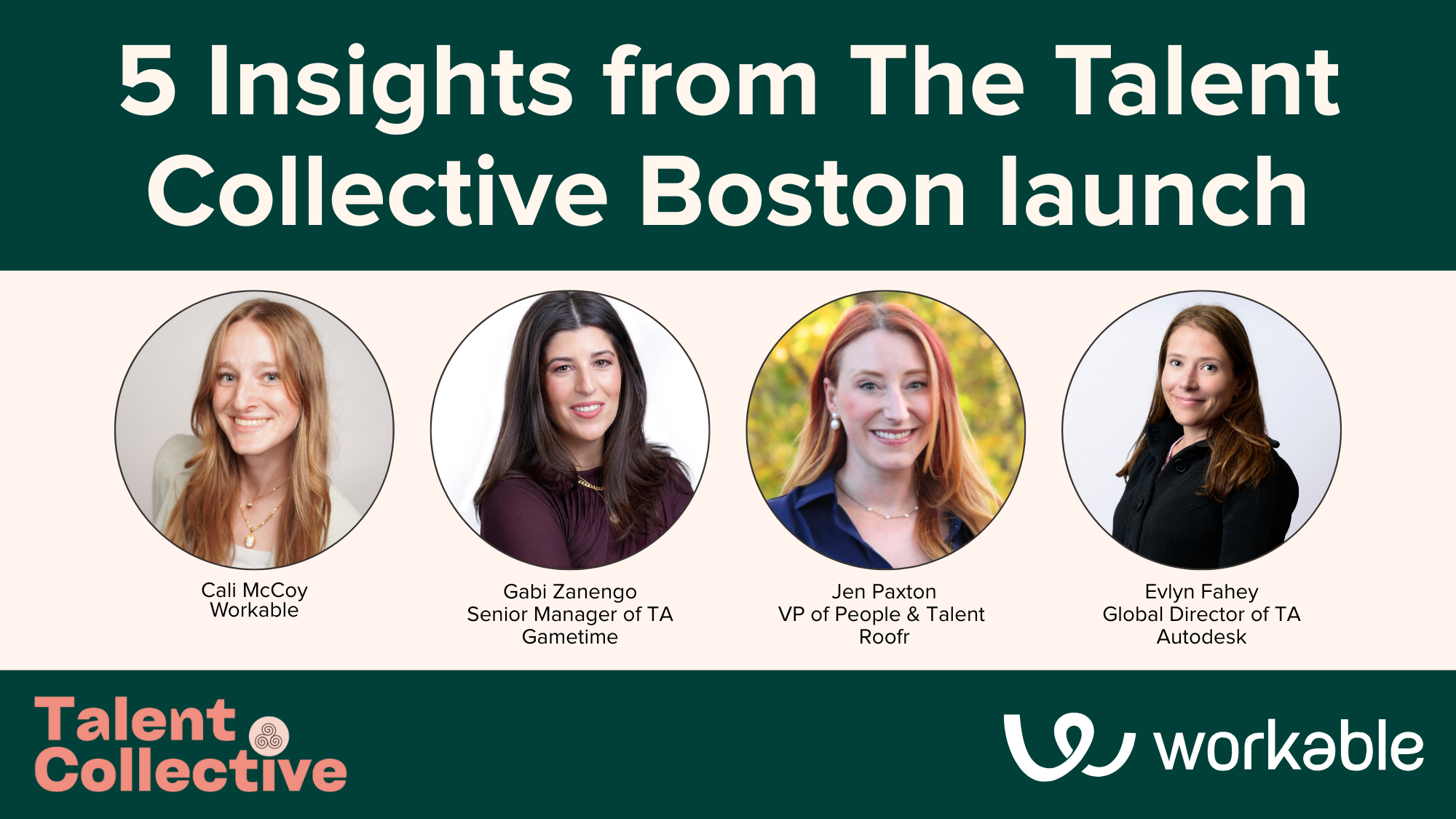How to use AI for a more personalized (and improved) candidate experience
Think back to the last time you applied for a job. When the job poster responded, did make you feel like an individual human being with something unique to contribute? Or did the response email start with “Dear candidate?”

In each case, how did you feel about the job poster?
Those two approaches make the difference between attracting the best talent available or losing them to a company that makes them feel like a person rather than a number.
A shrinking talent pool and increased demand for specialized skills has made it harder for recruiters to attract the right candidates. A personalized candidate experience can improve your odds and make it more likely for candidates to choose your company over others.
The problem is, how can you offer that personalization when you have 100s or even 1,000s of candidates vying for the same opportunity?
The answer is AI. Using AI for candidate engagement, you can offer that level of personalization at scale. When you balance AI with the human touch, you can manage communication with large volumes of applicants and still build relationships with them one-on-one as people.
This post will show you how to use AI for personalizing candidate communication and how it improves the experience for both you and your candidates.
Contents
Benefits of using AI for personalized candidate communication
You can use AI tools to send tailored messages to your candidates. You can address them by name, reference their specific skills and work experience, respond to their questions, and update them on the status of their application.
This level of personalization helps you stand out from organizations that rely on generic templates, making your communication more engaging and effective. Think of how off-putting it was the last time you got a copy-pasted rejection email.
There are several areas where AI personalization improves your hiring process and candidate experience:
- Improved speed and efficiency: Automating candidate follow-ups lets you manage communication with large numbers of applicants, which reduces time-to-higher and improves your conversion rates for job openings
- Continuous engagement: AI-automated follow-ups and reminders keep candidates in the loop at each stage of the process so they don’t drop off
- Improved responsiveness: You can offer candidates immediate feedback to queries so they can feel informed
- Quick decision-making: You can process large volumes of data and make faster decisions about which candidates to move through the next stage of the hiring process
- Improved quality of hires: Ai matches candidates with the job openings that best align with their skills and work experience
This combination of better decision-making, personalized experiences, and higher-quality hires strengthens your employer brand. That makes you more attractive to potential job seekers. It also makes life easier for you as a recruiter.
How to use AI for personalizing candidate communication
All well and good, but how do you put this technology to use in your own candidate outreach?
A good place to start is in your first interactions with the candidate. Use AI at the points in the process where the candidate is just entering your recruitment pipeline, from the point where they send their job applications to scheduling their first interview.
That frees up more time for you to interact with your shortlisted candidates who make it through the final steps in the process.
Dynamic email templates
With AI tools, you can segment your talent pool and tailor the content of your outreach emails based on their job role, application status, or past interactions with you.
Start with using candidate-specific details like their name, the job they applied for, and the date of their first interview. AI-automated emails can then fill in the templates with the right information so that each email you send out seems timely, personal, and relevant.
You should also split-test the email templates and improve your approach based on which one gets the highest response rates, so you can refine your templates over time.
Automate follow-ups and interview reminders
AI helps keep candidates informed about their status in the hiring process and the next steps, ensuring they remain engaged.
Set up automated workflows triggered by key stages in the interview process, such as application submission or interview scheduling.
Use AI-powered tools to streamline this process. This streamlines the process and reduces the risk of no-shows on the interview day.
Using AI in candidate nurturing, you can then send automated messages that will help the candidate succeed. Offer interview preparation tips. Give them information on what to expect next. Keep them informed and engaged, so they are less likely to drop off.
After the key stages of the process, request feedback. Encourage your candidates to share their experience and offer insights on how it can be improved. What information was helpful to them during the interview process? Use that information for your next iteration of AI candidate emails.
Personalize rejection letters
Just because a candidate isn’t the right mutual fit now, it doesn’t mean they won’t be later.
Handling rejection well keeps the door open for future opportunities with your company. Using AI in candidate nurturing can help with this part of the process too.
Use AI to analyze interview data and offer customized candidate feedback for each interview. Highlight their strengths, point out potential areas for improvement, and clearly explain why they aren’t the right fit at this time.
Using AI to personalize this part of the experience leaves the candidate with a good impression of you and your organization. Offering detailed and personalized interview feedback makes candidates feel respected and valued, so they’ll be more likely to apply again in the future.
It’s also a good reflection of your brand. Letting each candidate know about the status of their application rather than ghosting them builds trust and shows that your company values transparency.
Re-engage past candidates with AI
Instead of starting from scratch, consider re-engaging candidates who previously applied for your job openings. It takes less time and costs less money to fill a role with a previous candidate than to start over with a new one.
AI can help you re-engage these candidates and encourage them to apply again.
Start with having it look through your Applicant Tracking System (ATS) to single out any candidates who might be a good fit for current job openings, leveraging AI-driven application status updates to keep them informed.
Set up automated emails to reach those candidates and highlight any job opportunities at your organization that fit their profiles. Make sure any outgoing messages are personalized with references to their previous interactions with the company.
Using AI-enhanced candidate outreach to continually re-engage your talent pool makes them ready to tap into whenever new roles or opportunities open up. Even if they’re not currently interested in new roles, personalized re-engagement can encourage them to refer other people in their network.
Common challenges of using AI for candidate communication, and how to overcome them
Using AI can make your hiring process faster, match you with better candidates and foster a great candidate experience. However, some recruiters are hesitant to use AI in their recruiting processes because of concerns like integration and impersonal communication.
The good news is that with the right approach, these challenges are completely manageable and can even be turned into strengths.
Ensuring personalization without losing the human touch:
One of the most common concerns about using AI for candidate communication is that it feels too impersonal or robotic. Candidates want to be valued as individuals, and automated messages can undermine that experience if they feel they are interacting with a machine rather than a human.
With thoughtful implementation, AI-generated personalized messages can enhance the candidate experience while still balancing AI with a human touch.
Train your AI systems to use language that reflects your organization’s brand and work culture.
For example, after a candidate applies, AI can send a personalized email that includes specific references to the candidate’s name, their skills and experience, and previous interactions. Include personalized greetings, contextual responses, and warm, inviting language. Use details from their resume or application so the message feels timely and relevant.
AI can handle many routine communications. However, it’s important to include human oversight, and include opportunities for human interaction at critical touchpoints in the hiring process, such as a final interview or major decision point.
Create a system where key decisions and communication are reviewed or made by human recruiters.
For example, if a candidate just completed a work assessment or second-round interview, AI can notify the recruiter to send a personalized follow-up message. After AI drafts a rejection email, the recruiter can further personalize it by referring to specific aspects of the interview or the role.
Technical complexity and integration
Implementing any new system or platform into your existing recruitment processes comes with its own set of technical challenges. Integrating with your existing ATS and Customer Relationship Management (CRM) tools can be a barrier, especially if your team has limited its resources.
The beauty of generative AI is that it makes AI and machine learning accessible to a general, non-technical audience. It comes down to finding the right tool for the job.
A few things to keep in mind here:
- Find user-friendly AI tools: Find AI tools that are designed for easy integration of your existing processes and systems. Look for AI solutions that offer plug-and-play capabilities or APIs that simplify integration
- Start small: Begin with a pilot program to test out AI on a small scale. That gives your hiring team to get comfortable with it and troubleshoot any issues before rolling it out company-wide
- Get vendor support and training: Partner with AI vendors who offer customer support and resources. They can give you guidance on how to integrate their AI tools with your existing HR processes, make adjustments as needed, and ensure optimal performance
Continue to monitor the AI system’s performance and review how well it’s functioning with your existing setup. Set up regular check-ins with your IT and HR teams to assess its integration with your ATS. Track metrics like system response times, and the seamless flow of accurate data between your platforms.
Use these strategies to Integrate AI and you can make the most out of the technology and minimize any disruptions.
Measuring ROI and effectiveness
Measuring the effectiveness of AI tools in personalizing communication can be challenging, making it harder to justify the investment to your HR team and stakeholders. Quantifying its use requires clear metrics and regular evaluation.
Start with defining clear goals tied to quantifiable metrics. These can be:
- Reduced time-to-hire
- Higher number of qualified candidates
- Improved candidate satisfaction scores
For example, you can set a goal of reducing time-to-hire by 20% within six months of using AI-generated personalized messages.
Many AI platforms come bundled with analytics tools that can report on Key Performance Indicators (KPIs). You can measure the effectiveness of different types of communication, response rates, and overall candidate engagement. Measuring these can help you single out trends, and assess what’s working and what can be improved.
Continually gather feedback from your candidates as well. Ask them about their experience with the communication they received. Use that feedback to tweak your AI strategies, and prove the value of using AI in the recruitment process.
AI can bring out the human side in your candidate relationships
Candidates expect to be treated as individuals, whose time is valued when they make the effort of going through your interview process. AI is how you can give that to them at scale.
When you use AI in your recruitment systems, you’re doing more than just keeping up with the latest HR SaaS trend – you are leading the way into the future of personalizing the candidate experience with automation.
Start small with AI. Test it out by using it to communicate with candidates. Refine along the way, and get feedback from your candidates. With dynamic email templates, automated follow-ups, and personalized feedback that gives specific contextual responses to candidates, you can stand out as an employer of choice.
Workable AI can recommend the best passive candidates for your job openings, and send personalized emails for candidate sourcing and outreach. Book a demo and see how AI can make your candidate relationships better than ever.
Frequently asked questions
- How can AI improve the personalization of candidate communication?
- AI tailors communication to individual candidates by analyzing their data and crafting messages that address their unique skills and preferences.
- What are the best AI tools for enhancing candidate experience through personalized communication?
- Some top AI tools include Workable, HireVue, and Textio, which offer features for automating and personalizing candidate communication.
- How does AI-driven candidate communication impact candidate engagement and satisfaction?
- AI-driven communication boosts candidate engagement and satisfaction by providing timely, relevant, and personalized interactions throughout the recruitment process.
- What are the challenges of implementing AI in candidate communication, and how can they be overcome?
- Challenges include maintaining a human touch, integrating with existing systems, and ensuring data privacy, which can be overcome with customized AI responses, pilot programs, and strong vendor support.
- How can AI be used to maintain consistent communication with candidates throughout the recruitment process?
- AI automates follow-ups, reminders, and status updates, ensuring that candidates receive timely and personalized communication at every stage of the recruitment process.



